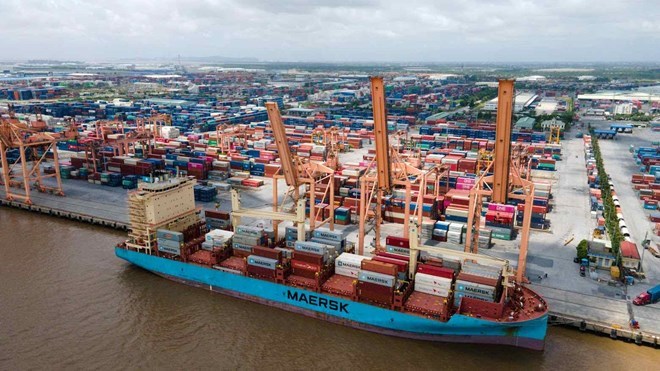The US - one of Vietnam's largest export markets - is becoming a hot spot as a series of key items face skyrocketing tariffs, possibly up to 46%. In particular, from April 5, 2025, the 10% general tax rate will officially take effect, along with trade retaliation measures expected from April 9, putting Vietnamese enterprises under unprecedented pressure. However, challenges also contain opportunities: Can this become a boost for Vietnam to strongly restructure the export system, improve adaptation capacity and added value?
Proactively expand the market, avoid dependence
The proportion of exports to traditional markets such as the US, EU and China still accounts for more than 60% of Vietnam's total export turnover in 2024. However, this also comes with risk if these markets have fluctuations in policies or consumer demand. Therefore, the diversification of the market has been promoted clearly. According to the Ministry of Industry and Trade, in 2024, export turnover to India increased by 12.5%, to Africa increased by 9.3%, Latin America increased by 8.1%compared to the previous year. ASEAN and Middle East markets also recorded positive growth. This is a testament to the market expansion efforts, reducing dependence and increasing adaptability of Vietnamese export enterprises.
Raising product standards to "go the long way"
Not only expanding the market, Vietnam is also upgrading product standards to meet increasingly high requirements on environment, labor and technology. Green, clean and responsible social exports are no longer a slogan but have been concretized by many businesses through action. By 2024, nearly 40% of textile and garment export enterprises have switched to using recycled materials or having environmental certificates; the seafood industry has also increased traceability and met standards such as ASC, BAP to maintain market share in the EU and Japan.
Value chain transformation: Add value, increase competitiveness
A positive change is that businesses have not only stopped at processing, but have initially participated in the design, brand building and application of technology in products. In 2024, exports of high-tech goods will reach more than 125 billion USD, accounting for about 45% of total turnover, showing a strong shift in the value chain. Many products such as electronics, components, medical equipment, and fashion products with Vietnamese brands have appeared in demanding markets such as the EU and North America, recording revenue growth of 15 - 20%.
Logistics and e-commerce: New lever for exports
Logistics costs still account for about 16% of GDP - higher than the global average. Developing logistics infrastructure and promoting cross-border e-commerce is considered a strategic solution to support exports. In 2024, the total export value via e-commerce platforms will reach more than 6 billion USD, an increase of 35% over the previous year. The fast-moving consumer goods, fashion, and processed foods sectors recorded positive growth through these channels.
From coping to proactive adaptation
The restructuring of exports shows a new mindset in operations and production and business. From being passive in responding to market fluctuations, Vietnamese enterprises are transforming to proactively adapt - from the market, products to approaches. This is a solid foundation to maintain sustainable export growth momentum in the coming period.

The role of the State and trade agreements
In the context of many uncertainties in the global economy, the participation of the State and the effective exploitation of free trade agreements (FTAs) are not only a driving force for export growth but also a "shield" to help businesses cope with market risks.
Taking advantage of FTA to expand the market, reduce risks
Vietnam is currently a member of many important trade agreements such as CPTPP, EVFTA, RCEP, etc. These agreements have opened a large door for Vietnamese goods to access potential markets. According to the Ministry of Industry and Trade, in 2023, export turnover to CPTPP markets will reach over 52 billion USD, an increase of nearly 15% compared to 2022, in which the markets of Canada, Mexico, and Chile recorded double-digit growth. EVFTA also plays a lever to help Vietnam penetrate deeper into the EU market. Export turnover to the EU in 2023 will reach 44 billion USD, of which items entitled to tariff incentives from EVFTA account for nearly 20%.
Establish an early warning mechanism, support trade defense
In an increasingly competitive global trade environment, the risk of being investigated for anti- dumping, anti-subsidy... is present for many key export industries of Vietnam. Therefore, the role of the State in establishing early warning and legal support mechanisms is extremely important. According to the Trade Defense Department (Ministry of Industry and Trade), in 2023, there were more than 25 cases of trade defense investigations related to Vietnamese goods, mainly in industries such as wood, steel, textiles, and seafood. Thanks to the timely support of the authorities, many businesses have overcome barriers and continued to maintain export market share.
Policy to support small and medium-sized enterprises in green transformation
Small and medium -sized enterprises (SMES) account for about 97% of the total number of Vietnamese enterprises but are the most vulnerable group when stepping into the international market. The State should continue to have practical policies to support this group to innovate technology, access green credit and promote trade promotion. For example, the digital transformation support program for small and medium-sized enterprises in the period of 2021-2025 was implemented by the Ministry of Planning and Investment, supported more than 6,000 enterprises to build a technological transition roadmap, thereby improving competitiveness. In addition, funds such as national technology innovation funds, Vietnam Environmental Protection Fund are gradually supporting businesses in the green conversion roadmap, meeting international standards.
The tariff barrier from the US is not only a challenge but also an opportunity for Vietnam to transform. This is the golden time to restructure exports in a sustainable direction, increase value and master the supply chain. Success requires close coordination between the State, businesses, associations and research and training institutions.











